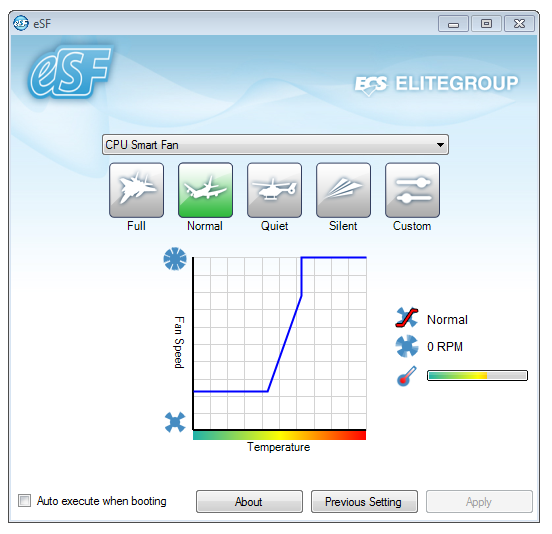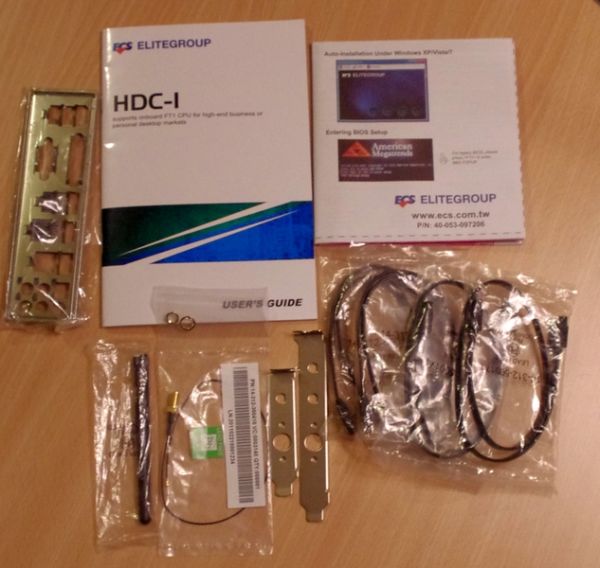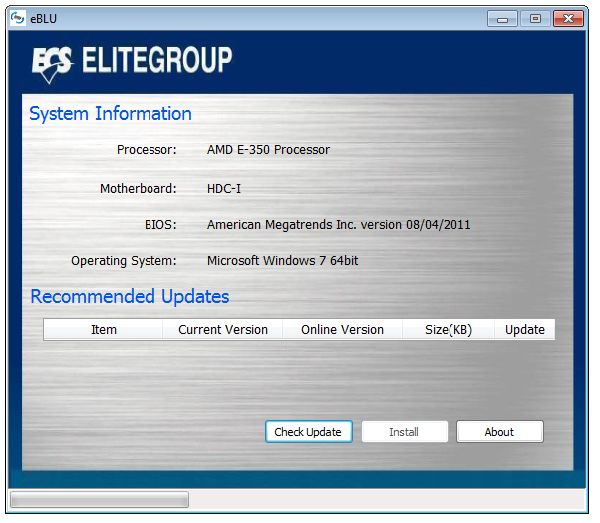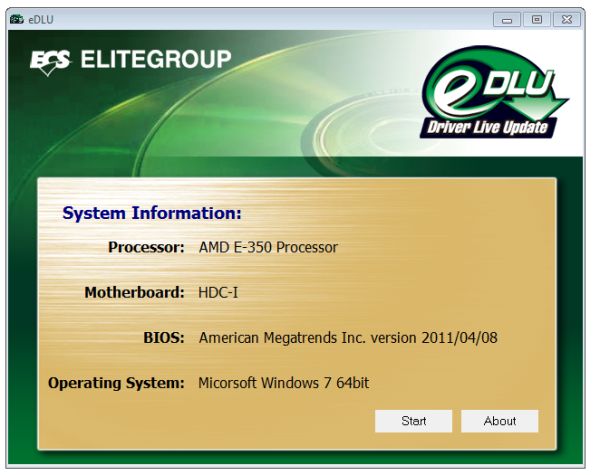Fusion E-350 Review: ASUS E35M1-I Deluxe, ECS HDC-I and Zotac FUSION350-A-E
by Ian Cutress on July 14, 2011 11:00 AM ESTBoard Features
| ECS HDC-I | |
| Market Segment | HTPC |
| CPU Interface | FT1 BGA |
| CPU Support | Fusion |
| Chipset | Hudson-M1 (A50M) |
| Memory Slots |
Two DDR3 DIMM Maximum 8 GB Non-ECC Unbuffered |
| Expansion Slots |
One PCIe x16 (x4 speed) One mini-PCIe for Wifi |
| Onboard |
4 x SATA 6Gbps Ports 2 x Fan Headers 1 x Front Panel Audio Connector 2 x USB 2.0 header |
| Onboard LAN | Atheros AR8151 Gigabit (10/100/1000) Ethernet |
| Onboard Audio | VIA® VT1708B 8-channel audio |
| Power Connectors | 24-pin ATX Power Connector |
| Fan Headers |
1 x CPU (4-pin) 1 x SYS (3-pin) |
| IO Panel |
6 x USB 2.0 HDMI VGA DVI 1 x eSATA 6 Gbps Gigabit Ethernet 2 x USB 3.0 (blue) Bluetooth Optical SPDIF Output 8-channel Audio |
| Warranty Period | 3 Years |
In The Box
ECS usually are quite good in what goodies get packed with a motherboard, though with a Fusion board, there aren't many available to include.
4x SATA cables (locking)
Wifi card, cable and aerial
2x brackets for the aerial, one half height
Manual
User Guide
Driver CD
The inclusion of the brackets is useful if you're using a case with two slots. The half height one is probably a good idea for thin system design. However they've had to include this here rather than as part of the I/O panel, but in return there are a couple more USB ports on the back.
Software
The ECS software range hasn't changed much since we last reviewed it - eSF is the smart fan tool, eBLU is the BIOS Live Update utility, and eDLU is essentially a weblink to a list of the latest drivers for the motherboard. As always, the Smart Fan utility works quite well, allowing for a temperature gradient to be set for fan speed - though this time it seems you can have a dual ramping system.

eBLU checks ECS servers online for the latest BIOS and compares it to the one currently in use.
eDLU is still a relatively simple program compared to its counterparts from other companies - again, I'd like to see this program actually list the current drivers on the system, and you can pick and choose the new ones directly from ECS all from within the software.













67 Comments
View All Comments
sprockkets - Thursday, July 14, 2011 - link
I have the AsRock board. I get 18w idle and 24w under load via a killawatt device. Granted it uses an 80w power supply, but I'm kinda wondering how you got 59w for something that is practically the same setup in each board.IanCutress - Thursday, July 14, 2011 - link
I was using a less than ideal power supply for the power draw tests which was very inefficient in this range (<20% of maximum power), and unfortunately I don't have anything more appropriate at hand to test with. The comparisons (I believe) between the boards are more than relevant though. I will hopefully rectify this in future reviews of lower powered systems.Ian
formulav8 - Thursday, July 14, 2011 - link
Why didn't you wait to do power consumption tests then?bah12 - Thursday, July 14, 2011 - link
While not ideal, I'd say the whole point of this article was to illustrate the differences in the boards. Thus as long as they all suffered from the same inefficient PS, the information is not useless in that you can still draw a conclusion based on the differences at the board level. All and all, not ideal but useful.BushLin - Friday, July 15, 2011 - link
I once tried to reason with the fanboys at AMDZone on Anands behalf, defending that the reviews here were objective... I think I'm starting to believe that their might be some truth in their beliefs that the odds are stacked against AMD when their products are reviewed on here.At best, this review is a misguided. It focuses far too heavily on areas these systems are not aimed at, misinforms (or fails to inform) on areas that it's market are interested in and answers stupid questions that no-one is asking. Testing a GTX 580 with an E-350 at 4x PCI-E... really? Why not test out how well these work as a HTPC compared to something like ION and the latest Atom?
At worst, this review could almost be seen as a deliberate undermining of a technology that's potentially superior to it's Intel's offering and how often could you honestly say that since Core2?. Most of the tests are irrelevant (or become irrelevant when comparing to much higher TDP chips), the one test you did manage to do which is very relevant (power consumption) was so high that it prompted me to look at other reviews and take the time to write this comment!
This review has idle power consumption as at least 36w, Xbit have it at 7.3w even with a 880w PSU. One of these reviews has it very wrong, I know which one I'm more inclined to believe.
http://www.xbitlabs.com/articles/cpu/display/amd-e...
IKeelU - Friday, July 15, 2011 - link
I have to agree with your assessment of the review.- These boards are aimed at HTPC market, but the review was focused...elsewhere (frankly, I can't tell what the focus was).
- How is the audio quality? I was very interested in the ASUS board until I noticed it doesn't have 6-channel direct out. This is important!
- Another, less important, point: The features/specs for each board should come first. Double points for a feature comparison table.
AnandThenMan - Friday, July 15, 2011 - link
It is extremely unfortunate that Anandtech has sacrificed their integrity when it comes to reviewing some of AMD's products. I really hope that more and more people are made aware of what is going on, these reviews are downright dishonest.The most important question people need to ask is, why is this happening? What is the incentive for Anandtech.com to publish these misleading reviews?
ET - Saturday, July 16, 2011 - link
Can you explain what is dishonest or misleading about this review? I agree that it could be better, but I don't see anything to indicate that anything was falsified here.medi01 - Sunday, July 17, 2011 - link
Seriously?Cough "This review has idle power consumption as at least 36w, Xbit have it at 7.3w even with a 880w PSU. ", cough?
Oh, it's irrelevant, because we're comparing motherboards of the same platform? Orly? What if I read this, say "OMG it consumes so much energy" and go buy Atom?
Tell me how to get that 36w idle thing, what kind of PSU should be used, to justify 7.3w (with bloody 880w PSU!!!!) vs 36w please?
What are 5850 580gtx doing in this review?
Shameless...
Finraziel - Thursday, September 1, 2011 - link
Monstrously late reply... but I just can't not leave this comment... Did any of you actually read the xbit article? Those power draw measurements are measured between the PSU and the components, only measuring what the components are actually using, completely ignoring the efficiency of the PSU (the way xbitlabs has been testing for years I might add). So the fact that they were using an 880W PSU has absolutely zero bearing on their readings.Granted, it's still a shame that these boards couldn't have been tested with something like a pico psu, and I do agree the article could have been better (for instance, how much noise does that tiny fan on the ECS board actually make? apart from an easily missed remark in the conclusion nothing is said about it), but it's not as bad as you people are making it out to be.